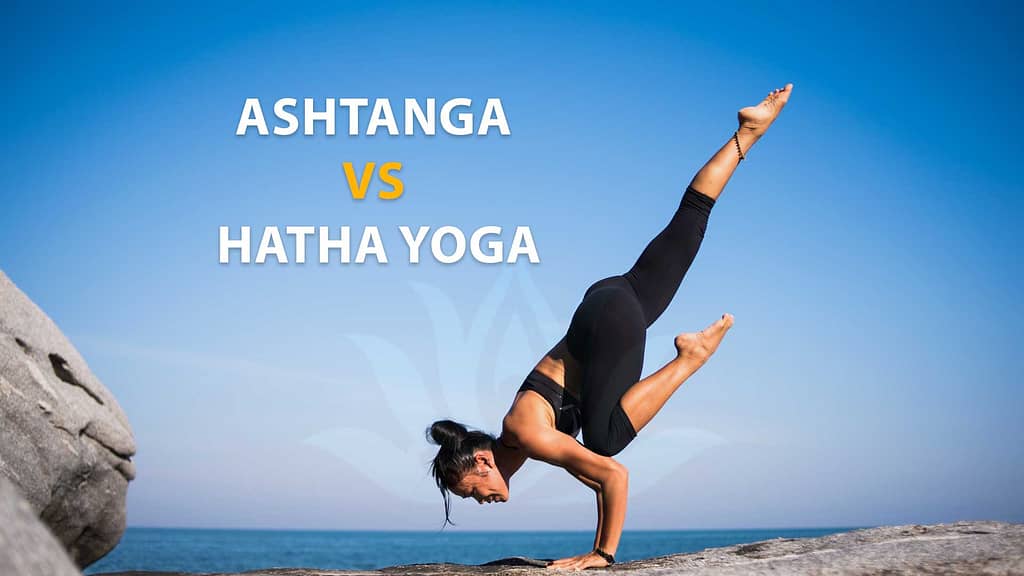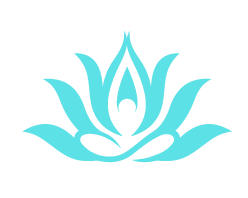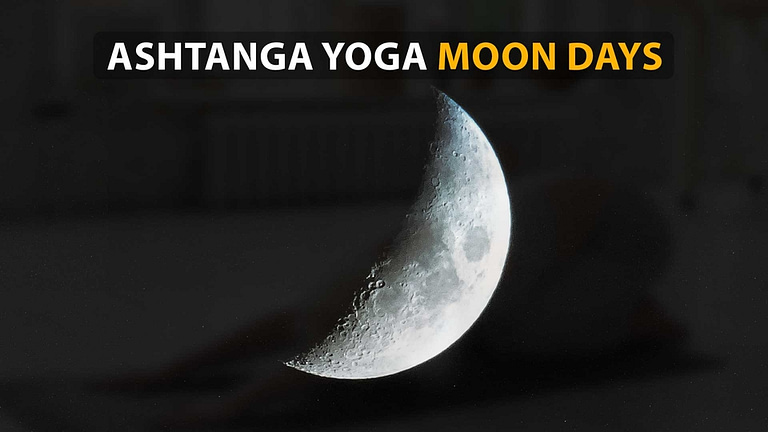Ashtanga Vs Hatha Yoga – Which Form Of Yoga Is Best In 2024

Ashtanga yoga Vs Hatha Yoga
Ashtanga yoga is an energetic, flowing style of yoga that calls for a particular set of postures and breathing techniques. It is an exhausting workout routine designed to increase heat and strength. Hatha yoga, which consists of a variety of postures, breath control, and meditation, is a more mild and relaxing kind of yoga.
Both are different in many ways. Hatha yoga emphasizes breath, posture, and meditation with a mindfulness focus. Ashtanga, on the other hand, focuses on building physical strength and strengthening muscles.
Ashtanga yoga has eight limbs, whereas Hatha yoga has seven. Ashtanga yoga centers on the self before transitioning to the practice of physical postures, whereas Hatha yoga begins with physical postures and eventually leads to meditation.
Ashtanga yoga focuses on the self and then moves on to physical postures and meditation, whereas Hatha yoga begins with physical postures that eventually lead you to a stronger meditation practice.
Hatha yoga
Hatha is a form of yoga that promotes breathing exercises, meditation, and physical postures. Hatha yoga has seven limbs, each significant to the practice.
It refers to moral and ethical standards and includes personal observations and postures to boost strength, balance and overall health. It enhances breath control and concentration and is gradual to meditation.
Ashtanga yoga
Ashtanga Yoga is a kind of yoga that focuses on a dynamic, flowing series of postures that are synchronized to the breath. It is sometimes known as “eight-limbed yoga.”
It has eight limbs which refer to moral principles, truthfulness, self-discipline, sun salutations, breathing techniques to synchronize with body movements and focus the mind on a specific object or point and enlightenment.
Read:
Can Beginners Do Ashtanga Yoga? Complete Guide In 2023
What is the difference between Hatha Yoga and Ashtanga yoga?

1- Hatha yoga takes more time.
More time is spent in each position than in Vinyasa or Ashtanga yoga.to maintain the position, to breathe correctly, and to stop tensing up when pushed. Hatha yoga is suitable for beginners who lack the stamina and energy for more energetic practices.
In contrast to other forms of yoga where we flow between positions, Hatha yoga allows for a more peaceful transition to the next pose.
2- Ashtanga Yoga Doesn’t Need Props
As hatha yoga is designed for beginners, it needs extra support. The props may balance and support injured individuals and help newcomers become more comfortable. While Ashtanga teachers usually do not instruct about props for practice.
3- Intensiveness of Ashtanga and gentleness of Hatha
While practicing Hatha, you can only do one asana at a time; Hatha is more efficient, As a warm-up, recovery workout, and relaxation. But with Ashtanga, you must continuously move through a set of asanas.
Moving quickly from one asana to the next makes the entire practice more intense, which increases internal heat production. Hence, Ashtanga is helpful for both rapid fat loss and dynamic strength development.
4- Different teaching styles for both Ashtanga and Hatha
Instructors can coach the class verbally or demonstrate part of or all the positions they have selected for that day.
While teaching Ashtanga Yoga, the instructor can use the previously discussed method and ask students to memorize the Ashtanga yoga poses and move through the set sequence at their own pace.
5- Hatha is freestyle, while Ashtanga is structured
The Ashtanga classes are consistent. Ashtanga yoga has a planned series of postures. A beautiful rehearsal, indeed, We engage in the same activity daily.
But this may appear dull to some people because so many other factors change. After all, your body, energy, and attitude are never the same. A hatha yoga session can be better for someone who enjoys variety and variation.
Read:
Does Yin Yoga Burn Calories? Benefits In 2023
6- variability of limbs
Ashtanga has eight limbs, as follows:
- Observances
- Abstinences
- Posture
- Breathing
- Withdrawal
- Concentration
- Meditation
- Absorption
While Hatha has seven, as follows:
- Yama
- Niyama
- Asana
- Pranayama
- Pratyahara
- Dharana
- Dhyana
Is Ashtanga the hardest yoga?
It is the most challenging type of yoga. It comprises six series, but most people only practice the first series over months or years.
Which is better Hatha or Ashtanga yoga?

Ashtanga and Hatha Yoga are healthy exercise variations, so your choice will depend on your tastes and needs.
Ashtanga yoga promotes a continuous series of postures coordinated with the breath. It is a physically challenging and organized practice. For those seeking a demanding and difficult practice, it is suitable. It may help with improving strength, flexibility, balance, and attention.
Hatha yoga, on the other hand, is a slower-paced, more peaceful kind of yoga that encourages a balance between physical postures, breathing exercises, and meditation.
It is most suitable for anyone searching for a more reasonable and efficient solution to yoga and may help improve flexibility, balance, relaxation, and general well-being.
The ideal kind of yoga for a single person depends on his needs, tempo, body, and physical capabilities. You should practice several yoga forms to find the one that works best.
Read:
What Is Special About Ashtanga Yoga? – 14 Benefits Of Ashtanga Yoga
Ashtanga yoga as a form of Hatha Yoga
Ashtanga is a part of Hatha yoga as a whole. Hatha yoga is a type of yoga that focuses on the physical aspects of the practice. And that’s why in a Hatha yoga class, you always move from one pose to the next by following your breath. So, Ashtanga yoga is like Hatha yoga in that it focuses on postures.
Hatha yoga Vs Ashtanga vs vinyasa yoga
The way each style of yoga is taught shows what its goal is. Hatha yoga emphasizes being aware by putting a lot of stress on the breath, stance, and meditation.
On the other hand, Ashtanga is all about building muscle and getting stronger. Lastly, Vinyasa looks at how the mind, body, and breath work together.
Conclusion
In short, Hatha and Ashtanga yoga are two separate yoga forms, each with special advantages and goals. Hatha yoga is more relaxed and peaceful, focusing on the coordination of breathing exercises, physical postures, and meditation.
On the other side, Ashtanga Yoga involves a flowing series of postures linked with the breath and is a physically challenging and disciplined practice.
Frequently asked questions: Ashtanga Vs Hatha Yoga
Q: What kind of yoga is the most simple?
Beginners because it moves more slowly. If this is your first time doing yoga, Hatha is a great class to start with. In a Hatha yoga class, it’s all about the basics. In a Hatha class, you move more slowly and hold each pose for a few steps.
Q: What’s the right amount of yoga?
In general, doing yoga for one hour three times a week is a good idea.
Q: Can you get in shape by doing yoga?
It’s a great way to work out, but it might not be enough for you if you don’t take classes like vinyasa or Ashtanga yoga which are more intense.
Q: Yoga or the gym? Which one burns more calories?
Running, pulling weights, and swimming burns more calories than yoga in the same amount of time. But yoga will also help you deal with worry and be more aware.
Video guide: hatha vs ashtanga
Read Also
- Is Yoga Aerobic Or Anaerobic? – What Separates Aerobic Activity From Anaerobic Exercise?
- Can Yoga Cause Diarrhea? – Which Yoga Poses Should You Avoid If You Are Facing Diarrhea In 2023?
- Why Do I Feel Sick After Yoga? – How To Prevent Sick After Yoga In 2023
- Is Fat Guy Doing Yoga? Easy Yoga Poses For Obesity In 2023
- What Is The Ashtanga Yoga Of Patanjali? A Comprehensive Guide In 2023
- Why Is Ashtanga Yoga Considered To Be The Most Difficult? – Complete Guide 2023






